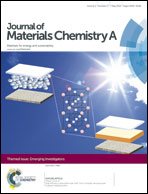A planar-defect-driven growth mechanism of oxygen deficient tungsten oxide nanowires†
Abstract
Tungsten oxide nanowires (NWs) have many applications and can be grown simply via vapor transport from solid WO3, but the mechanism by which they form is not well understood. We performed a series of vapor transport tungsten oxide growth experiments with controlled oxygen partial pressures, source-to-substrate temperature differences, and with W or WO3 substrates. The resulting films were analyzed using electron microscopy, diffraction, and photoelectron spectroscopy. NWs formed only under sufficiently reducing conditions where substoichiometric compositions (e.g. ∼WO2.9) were obtained. Transmission electron microscopy (TEM) analysis of the NWs revealed extended defects parallel to the (010) NW growth direction, similar to those found in bulk samples that are associated with ordered O vacancies. Cross-sectional TEM analysis showed that the defects appear to bound, and thus potentially stabilize the nanowire surface to preference the 1D growth. NWs annealed in air show decreasing defect concentrations with increasing temperature and a progressive collapse of the 1D morphology. These results support a mechanism where oxygen-deficient substoichiometric planar defects oriented parallel to the NW long axis direct the NW growth. This mechanism is likely relevant to other oxide nanomaterials that form extended defects due to oxygen non-stoichiometry. The role of defects in controlling the growth morphology is also important for NW applications because the defects may be beneficial (e.g. for thermoelectrics) or detrimental (e.g. for photoelectrochemical cells) to device performance.

- This article is part of the themed collection: Emerging Investigators

 Please wait while we load your content...
Please wait while we load your content...